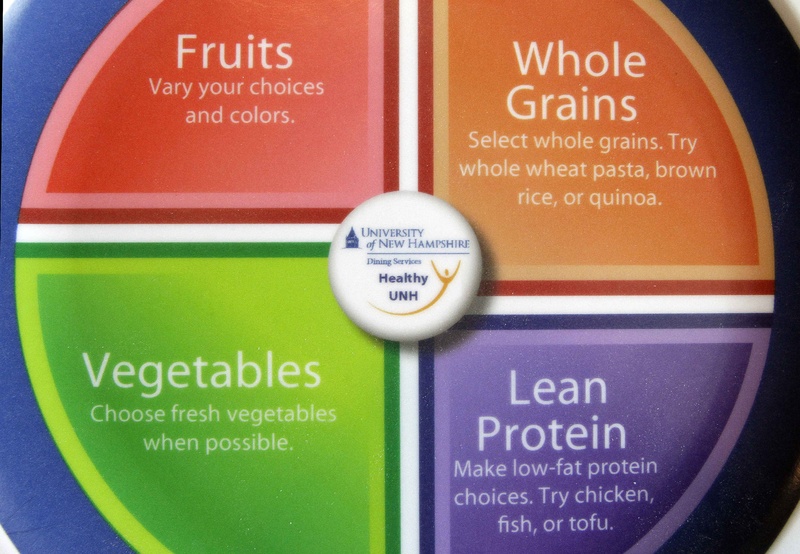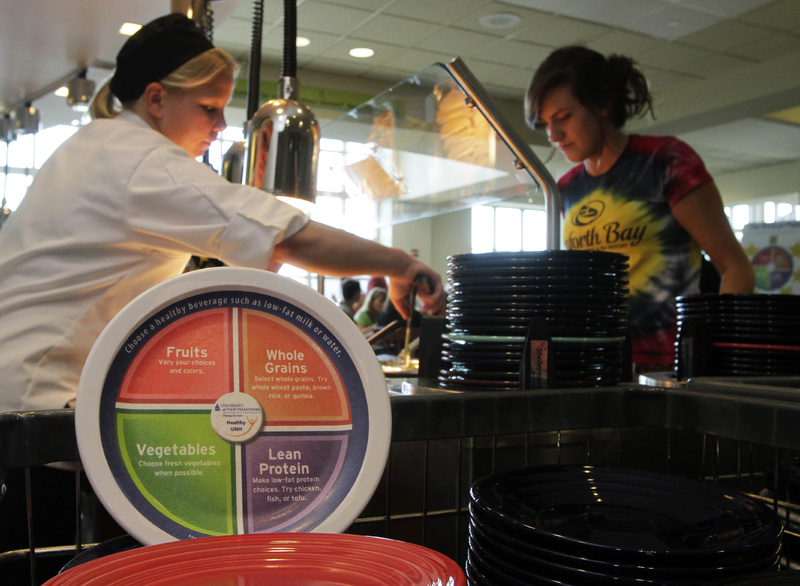DURHAM, N.H. — They may not be binging on broccoli, but some University of New Hampshire students are at least pausing before they fill up on fried food, thanks to dishware designed to remind them about healthy options.
Two years after the federal government abandoned the food pyramid as a symbol for healthful eating and adopted an image of a plate instead, the university has gone a step further by printing dietary guidelines directly on plates used in campus dining halls.
The so-called Wildcat Plates, named after the school’s mascot, offer a bit more detail than the “My Plate” graphic promoted by the U.S. Department of Agriculture. While the USDA image shows a plate divided into four segments labeled “fruits,” ”vegetables,” ”grains,” and “proteins,” the Wildcat plate specifies “lean protein” and “whole grains” and offers suggestions such as “try whole wheat pasta, brown rice or quinoa.”
Like schools around the country, UNH has revamped its dining halls in recent years to add healthier – some would even say gourmet – offerings. The university has set a goal of becoming the nation’s healthiest campus by 2020 and believes the new plates are a helpful tool for students who may be away from home and making their own food choices for the first time, said Jo Porter, deputy director of the New Hampshire Institute for Health Policy and Practice.
“They’re moving from a place where sometimes their dining experiences at home were kind of dictated by their parents, and now they have a lot of freedom, which is great in some ways, but this becomes one of the helpful reminders for how to eat well,” she said. “Some people will use them to get kind of a sense of what a healthy plate looks like, and then ingrain that in their everyday living and not need that plate every single time.”
The plates, made of melamine, are mixed in with the university’s standard ceramic plates, with about 1,300 circulating through three dining halls that serve 12,000 meals per day. During one recent lunch hour, some students piled their plates with veggies, while others reached for grilled cheese, pasta and sausage. Freshman Mike Carbone covered the fruit and vegetable portions of his plate with fried onion rings and the protein section with grilled chicken. There was a pile of chicken nuggets in the middle, and blobs of ketchup and mustard in the grain section.
“It’s not a very nutritious lunch, but I’m drinking water,” he said.
Carbone, 19, said he does try to eat healthily but said he pays no attention to the plates.
Sophomore Nicole Grote said while she doesn’t match her food to the plates, they’ve made her more aware of portion sizes, and in general, she thinks the university is taking the right approach.
“I think it makes sense,” said Grote, who stays away from both sugar and dairy products. “People should eat healthy.”
Peter Heislein, a junior, said the plates have prompted him to choose an apple instead of french fries on occasion, but they have not been a major influence on his diet. And his main reason for preferring the plates had more to do with how they emerge from the dishwasher than the healthy message.
“I wish it was better than this, but I like them because they’re not searing hot like the ceramic plates,” he said. “It does make a little (health) conscious, but not a ton.”
Dining hall manager David Hill said he has seen some students taking the plates seriously, while others ignore them. It’s all part of the challenge of keeping up with students’ changing tastes while also promoting health, he said.
“We’re always trying to infuse more healthy options as a choice, but we don’t impose it on people,” he said. “That’s really our strategy: to have a balance.”
A number of versions of the plates are available commercially, and they’re often used as teaching tools, said Dr. Robert Post, acting executive director at the USDA’s Center for Nutrition Policy and Promotion. He did not know of other schools that have been serving food on the plates like UNH but said many are using the image in banners and posters.
And since the USDA launched its “My Plate on Campus” initiative in the spring, he said, more than 800 students in all 50 states and nearly a dozen other countries have signed up to become ambassadors who encourage healthy eating at their schools.
The Wildcat plates are manufactured by a New Hampshire company. With USDA permission, UNH has copyrighted its modified design and hopes to license it to other high schools and colleges that could add their own logos to the plates and use them in their dining halls.
Send questions/comments to the editors.




Success. Please wait for the page to reload. If the page does not reload within 5 seconds, please refresh the page.
Enter your email and password to access comments.
Hi, to comment on stories you must . This profile is in addition to your subscription and website login.
Already have a commenting profile? .
Invalid username/password.
Please check your email to confirm and complete your registration.
Only subscribers are eligible to post comments. Please subscribe or login first for digital access. Here’s why.
Use the form below to reset your password. When you've submitted your account email, we will send an email with a reset code.